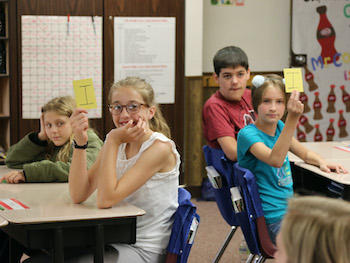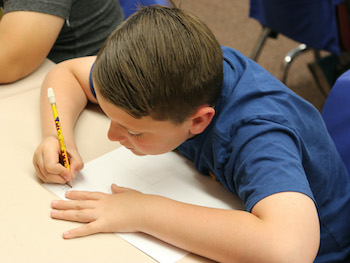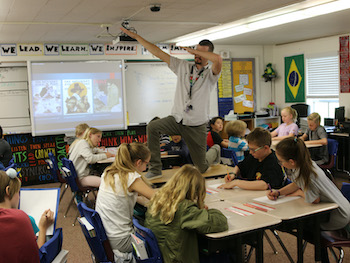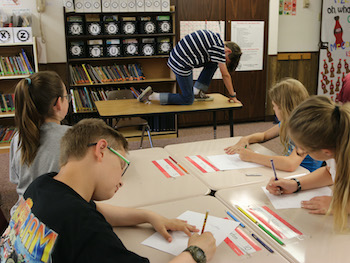SUBJECTS
GRADE
Show Results
Thanksgiving Illustrated

Lesson Summary
- Learn about Norman Rockwell and the role of an illustrator.
- Compare three of The Saturday Evening Post covers.
- Design and illustrate a cover for The Saturday Evening Post.
Lesson Plan and Procedure
Lesson Key Facts
- Grade(s): 3, 4, 5
- Subject(s): Social Studies, Visual Arts
- Duration of lesson: 45 minutes
- Author(s): Christine Palmer
Illustration vs. Painting
Ask students if they are familiar with the word illustration. What is an illustration? How does an illustration differ from a painting?
Teacher: A painting doesn’t have to say or do anything. It can just be a painting, although many paintings do tell stories. An illustration is created specifically to make something clear or to tell a story. An illustration tells a story with a picture.
Divide your students by tables or groups, and choose one captain in each table or group to hold a piece of paper with a bold, uppercase i written on it.
 Show the linked PowerPoint presentation of images (“Illustration vs. Paintings”). As each image appears, have the students at each table discuss whether or not they think it is a painting (doesn’t tell a story) or an illustration (tells a story). If they think it is an illustration, the table captain will hold up their i paper. Discuss with your students the possible meaning of the illustration or why they felt it was an illustration or a painting.
Show the linked PowerPoint presentation of images (“Illustration vs. Paintings”). As each image appears, have the students at each table discuss whether or not they think it is a painting (doesn’t tell a story) or an illustration (tells a story). If they think it is an illustration, the table captain will hold up their i paper. Discuss with your students the possible meaning of the illustration or why they felt it was an illustration or a painting.
Norman Rockwell was an American painter and illustrator whose work reflected American culture. He was known for the illustrations of many of the covers for The Saturday Evening Post magazine.
Note: Show only 10 of the 11 slides. The last slide shows three Thanksgiving covers illustrated by Norman Rockwell and Joseph Christian Leyendecker that will be discussed in the next section. They are in this PowerPoint presentation so that you can show them in a large format. The students will view the last slide to contrast the meanings, not so much to determine whether or not they are illustrations.
The Saturday Evening Post
 Have students look at the Thanksgiving covers for The Saturday Evening Post shown on the final slide. Although the covers are all depicting the same holiday, they tell three very different stories. Why?
Have students look at the Thanksgiving covers for The Saturday Evening Post shown on the final slide. Although the covers are all depicting the same holiday, they tell three very different stories. Why?
Have students speculate potential meanings for each. Let them share their inferred meanings. You can point out clues, but it doesn’t matter here if they are wrong or right. You just want the students observing and talking about potential meaning based on imagery. Ask the students what they think the illustrator hoped the viewer would gather from each cover.
This would be a good place to validate and appreciate students from other cultures and how their Thanksgivings might look different from that of other students in the class. Take the time to recognize the diversity in the room.
Explain that the biggest difference between an artist and an illustrator is that an illustrator is always trying to tell a story through the images.
Illustrated by YOU!
 Students will now illustrate their own Thanksgiving covers for The Saturday Evening Post.
Students will now illustrate their own Thanksgiving covers for The Saturday Evening Post.
Begin by having students generate ideas for their illustrations by sketching thumbnails on practice paper, visualizing, and/or writing down their ideas. Their ideas can be about a Thanksgiving memory, a Thanksgiving tradition, the first Thanksgiving, or what Thanksgiving looks like in their family. Writing a paragraph about their ideas can help students make an illustration choice.
Many students will choose to have people in their illustrations. Stress that figures performing an action will add interest to their art. Strengthen their figure-drawing skills by having students practice gesture drawing (capturing movement through quick and simple sketches).
Invite a student to stand in the middle of the room and take a pose that shows an action such as running, skating, or swinging a bat. Have students notice the straight lines on the body, and encourage them to begin to draw. Give students about 10 seconds to sketch before another action pose is taken by the model. Have the students take turns modeling for the class. You can extend the lesson by taking the students outside to view and draw other students at recess, or by asking the PE teacher if your class can come into the gym for 15 minutes to create gesture drawings of students who are moving around. Give students time to practice and direction about how to incorporate their new knowledge into their illustrations.


Using the attached template, students will illustrate their own Thanksgiving covers for The Saturday Evening Post. They should begin sketching their illustrations and deciding how to depict their ideas visually. Encourage them to problem-solve, experiment with ideas, and provide one another with feedback on the art making. Display the completed artwork.
This is a wonderful opportunity to create art that celebrates students’ cultural traditions. This lesson can be a powerful learning experience about each other and the diversity within a classroom.
Learning Objectives
- Distinguish the difference between an illustration and a painting.
- Analyze and interpret works of art.
- Illustrate a personal Thanksgiving-themed The Saturday Evening Post cover.
- Practice gesture and figure drawing.
- Represent community cultural traditions.
Utah State Board of Education Standards
This lesson can be used to meet standards in many grades and subject areas. We will highlight one grade’s standards to give an example of application.
Grade 4 Social Studies
Standard 4.3.1: Use primary sources to compare experiences of at least three groups’ migration to Utah between 1847–1896 (for example, members of The Church of Jesus Christ of Latter-day Saints, people from Greece, Italy, China).
Standard 4.5.6: Choose one of Utah’s cultural institutions, and explain its historical significance as well as the cultural benefits to Utah families and our nation.
Grade 4 Visual Art
Strand CREATE (4.V.CR.): Students will generate artistic work by conceptualizing, organizing, and completing their artistic ideas. They will refine original work through persistence, reflection, and evaluation (Standards 4.V.CR.1-4).
Standard 4.V.CR.1: Brainstorm multiple approaches to a creative art or design problem.
Standard 4.V.CR.4: Revise artwork in progress on the basis of insights gained through peer discussion.
Strand RESPOND (4.V.R.): Students will understand, evaluate and articulate how works of art convey meaning for the observer as well as the creator (Standards 4.V.R.1-4).
Strand CONNECT (4.V.CO.): Students will relate artistic skills, ideas, and work with personal meaning and external context (Standards 4.V.CO.1-2).
Standard 4.V.CO.1: Create works of art that reflect community cultural traditions.
Standard 4.V.CO.2: Through observation, infer information about the time, place, and culture in which a work of art was created.
Equipment and Materials Needed
- Projector
- PowerPoint presentation “Illustration vs. Painting”:
https://www.slideshare.net/ChristineBrownPalmer/illustrations-vs-paintings - The Saturday Evening Post template
- Pencils (regular and colored for illustrations)
- Erasers
- Papers (about six) with the capital letter i printed on them
Additional Resources
- The “Just for Teachers” page on the Plimoth Plantation website is a great resource with interactive activities: https://www.plimoth.org/learn/just-teachers
- Scholastic’s “The First Thanksgiving” page brings multiple perspectives of Thanksgiving into your classroom: http://www.scholastic.com/scholastic_thanksgiving/index.htm
Image References
*All images in PowerPoint presentation are cited on each page.
- Image 1: Freedom from Want, Norman Rockwell, 1943.
- Image 2-6: James Huston.

www.education.byu.edu/arts/lessons
 Download
Download